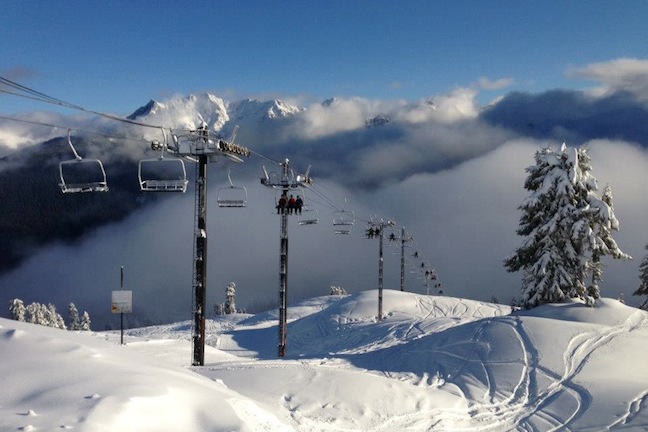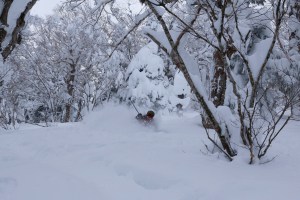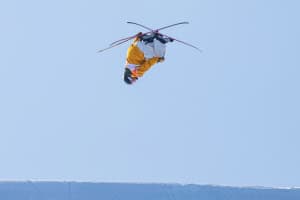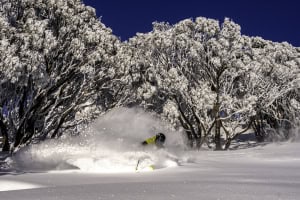STUDY – NRDC and POW Examine Climate Change and the U.S Ski Industry

Under a warming climate, opening days like this one at Mt Baker will become a thing of the past Image:: Mt Baker
Mountainwatch | Alex Horvath
It doesn’t take a climate scientist to realise that the impact of a warmer world is bad news for snow. However, despite the seemingly obvious implications for the winter tourism industry, the issue has thus far not been recognised by policy makers in the United States or elsewhere. The U.S based Natural Resources Defence Council (NRDC) has teamed up with well known not-for-profit organisation Protect Our Winters (POW) to change this. The organisations have presented a comprehensive report on the expected impact that climate change will have on the winter sports industry. The outlook, as you can imagine, is bleak.
Here at home, we are all too familiar with the ‘knife edge’ freezing level situation that dictates whether we see 40 cm of fresh or 40 mm of rain. Under a warmer climate, these systems are going to fall as rain a lot more often. Last year, the Australian Federal Government published a report entitled “Caring for our Australian Alps Catchments”, this report outlined the physical impacts that are likely to occur under the current emissions forecasts. The main conclusion reached in the report was that by 2050 the Australian Alps are likely to see an increase in average temperatures of between 0.6 and 2.9 degrees. The report stated that this would essentially mean a 96% reduction in the area covered by snow for 60 days or more by 2050. Within our lifetime, we could see the end of winter snow sport in Australia.
The report published by NRDC and POW essentially takes previous knowledge about the ramifications of climate change in the US, and adds a financial value to these impacts. The stimulus for this report came from POW founder Jeremy Jones, and the rest of his team, travelling to Washington D.C with prominent professional winter athletes in order to provide first hand accounts of climate change to the politicians that needed to hear them. The congressmen they spoke to replied, “…before they can consider any real climate legislation on our behalf, they needed numbers that clearly showed the economic impact of winter sports in their individual states – how many jobs will be lost and the what’s the loss of state revenue when it doesn’t snow?” said POW’s Executive Director Chris Steinkamp, “We took that as a mandate, and with the NRDC and two researchers, we spent the last eleven months researching the data and finally have an answer. Again, it’s the first report of its kind and we’re very proud of it.”
There is no doubt that the impacts of climate change on alpine areas will be dramatic, the report outlines, “The snow sports community has seen some of the earliest and most tangible evidence of climate change’s impact on our nation’s mountains. Impacts have ranged from reduced snowpack and melting glaciers to dying alpine forests and shorter winter seasons. Climate change is already happening and we are seeing its effects every day.”
With the complex web of stakeholders, and the difficulties of petitioning for change when governments and politicians are involved, the report has added to the natural evidence by quantifying the financial ramifications that will occur as a result of climate change without the required action. Some of the key findings are;
- Climate change, if not actioned, will result in a loss of 211,900 jobs and $12.2 billion in value added to the U.S. economy per year.
- Only four out of 14 major ski resorts will remain profitable by 2100 under a higher-emissions scenario.
- A reliable snowmobile season (more than 50 days of natural snow cover) will be completely eliminated.
- Park City, Utah will lose all mountain snowpack by the end the century while Aspen will be confined to the top quarter of the mountain under a higher emissions scenario.
- Snow depth is expected to decline by 25 percent in the western United States and will disappear entirely at lower elevations.
This report will hopefully herald the next phase in recognition of the need to protect our winter assets. The work of POW and the NRDC should signal to legislators the huge importance of the winter tourism industry and begin to effect change. If global economies like the United States take notice and implement effective solutions, then fingers crossed this will grab the attention of the government back home in Australia.
Read the full report HERE






